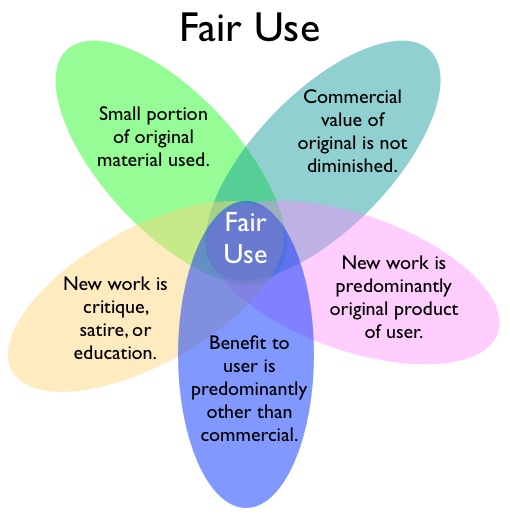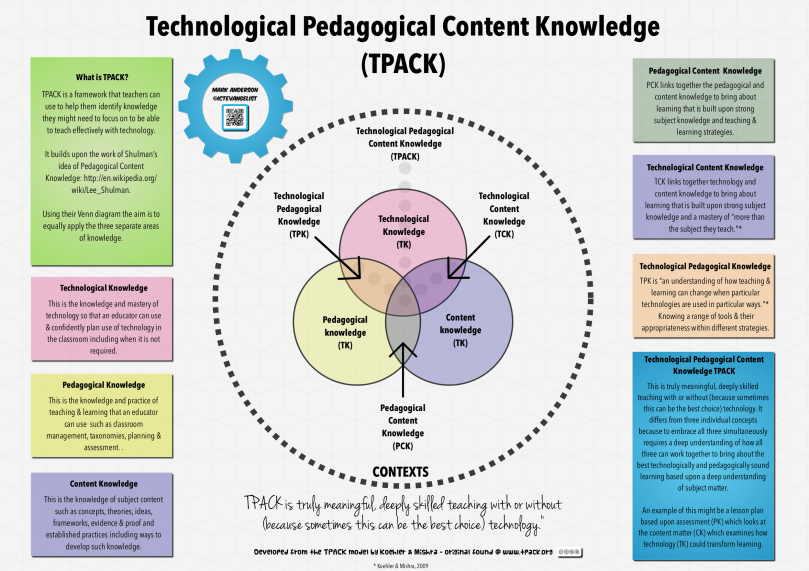My biggest takeaway from this class is that technology should have a purpose in the classroom. This sentiment echoes a previous post of mine, which went in depth on the ISTE standards and the SAMR Model. Learning about those two concepts have really helped me understand how and why I shouldn’t just throw technology into my lessons without intention. This may sound like a straightforward concept, but when administrators buy some shiny new technology worth thousands of dollars, teachers are expected to use it whether or not it actually adds to their lessons. So understanding the roles technology should have in the classroom helped me understand how I can try to integrate a wide variety of tools in a way that furthers my students’ learning.
Resources for Language Teachers
Since the beginning of my teacher education program, I have discovered so many great resources on pedagogy, technology integration, and second language acquisition. Because I’m a nerd, I want to share some SLA resources with you. Who doesn’t want to talk pop-up grammar, circling questions, PQAs (Personal Questions and Answers for those of you unfamiliar), and more?
First up, a podcast! Tea with BVP is hosted by Bill VanPatten, Angelika Kraemer, and Walter Hopkins. Bill VanPatten is an SLA researcher at MSU while Angelika Kramer and Walter Hopkins are instructors and directors of language programs at the school. In the podcast, you’ll hear great conversations about teaching foreign languages and the research behind methods like TPRS and Comprehensible Input. I really enjoy their discussions about more traditional teaching methods versus CI. Because I am used to more traditional classrooms as a student, I like to understand what those methods really do for language acquisition in comparison to something like CI, which I am determined to become proficient at. With my background, sometimes it’s hard for me to wrap my mind around ditching traditional methods like explicit grammar. Luckily, there is an episode of Tea with BVP that discusses the role of explicit grammar teaching in acquisition! If you have an SLA-related wondering, there’s probably an episode about it.
You can listen to Tea with BVP live on Mixlr on Thursdays at 3 PM ET. The show is also available on Soundcloud and iTunes. Not only is this podcast informative, it is also really entertaining. All three hosts are funny, friendly, and passionate about the topics they discuss. It is fun to listen in on their conversations. If you don’t just want to listen in, you can join the conversation during their live shows and call in with a question or comment! Overall, Tea with BVP addresses really important topics in the domain of world language teaching and has the backing of current research.
Next, Martina Bex of The Comprehensible Classroom is a great TPRS teacher who shares so many resources, tips, and tricks. I’m still very much in the middle of learning how to implement TPRS in my own classroom, and her blog has been such a great support. She has a whole series of posts to help you understand the very basic strategies of TPRS. If you’re a Spanish teacher, you’re especially in luck because Martina has curriculum maps and lessons for Spanish I and II. She also has some resources in French, and, of course, these can be adapted for any language. If you’ve never seen TPRS in action, she recently posted a clip of her teaching a demo lesson. See below!
If you’re just getting started, The Comprehensible Classroom is an indispensable resource!
Lastly, go follow Alina Filipescu (@FilipescuAlina) on Twitter! I first saw Alina at the Fall COACH Workshop (Bonus shout out to COACH Foreign Language Project, an awesome organization of foreign language educators based in Southern California. If you’re in the area in August, try to make it to their summer Kick-Off. I might be there!). At the workshop, Alina did a live demo lesson with her eighth graders. It was my first exposure to TPRS in action, and I was totally mesmerized! The level of engagement from eighth graders on a Saturday morning was unreal. On Twitter, Alina shares her favorite resources for TPRS/CI instruction. She also contributes to the blog TPRS for Chinese. Follow her to tap into the incredible TPRS/CI community!
Have fun exploring these awesome resources!
Chontelle
Digital Citizenship
For teachers, the Internet can be an incredible resource. You’re reading this, I’m assuming, because you want some kind of insight into teaching or educational technology. In addition to information, there are tons of images, videos, songs, and other materials that can add so much to student learning. Too many teachers, however, use these materials whose owners have not given permission for others to use or without citing the materials. We should be modeling good digital citizenship for our students so they know how to navigate the scary world wide web responsibly. We don’t want our students stealing digital content, do we? ISTE has outlined nine aspects of digital citizenship if you’d like to know more.
So let’s break this down. If you want to keep your classroom content interesting by adding outside sources, you’ll need to know about a few things. Let’s start with copyrights. Unless otherwise stated, things on the Internet are owned by their creators. You cannot use, manipulate, or copy them without permission from their owners.
Educators, though, have a little more wiggle room when it comes to copyright. Fair use allows educators to use videos or other materials for educational purposes. You should be careful because if you show a movie or song to your class that does relate to your curriculum, you are breaking the law. The image below, taken from Houston Community College, outlines the terms of fair use a little more clearly.

So what can we use?
Look for materials with the Creative Commons symbol!

Creative Commons is a company that offers free licenses for materials you create. The owners of materials with this symbol have given their permission for others to use them under certain guidelines. Some materials may not be altered without violating the law while others can be altered as long as you properly give credit to the creator.
It’s always a good idea (more like required) to attribute images and other materials to their original owners. Make it a habit!
As usual, there are other people out there much more knowledgeable than I. Go visit The EduBlogger for more information about this very important topic.
À bientôt,
Chontelle
TPACK + SAMR
Anyone familiar with these acronyms? Up until four weeks ago, these two combinations of letters were a complete mystery to me. I don’t claim to be an expert on TPACK or SAMR, but I’d love to share what I do know with fellow teachers or anyone else interested in integrating technology for educational purposes. Be prepared, there are even more acronyms heading your way!
TPACK stands for Technological, Pedagogical, and Content Knowledge. The graphic below does a good job at summarizing this framework, if you would like a concise explanation.
TPACK builds on the ideas of Lee Schulman who explained Pedagogical Content Knowledge (PCK) as the blending of what teachers know about teaching (pedagogy) and what they know about their specific discipline, whether it be math, ELA, or French. PCK says that teachers need to bring together the how of teaching (Pedagogical Knowledge) and the what of teaching (Content Knowledge) to teach effectively. Educators must take what they know about their content and what they know about good teaching to create effective lessons.
As there are more and more technological advances in the world, teachers need to be comfortable with integrating technology into their classroom. TPACK emphasizes the importance of bringing in knowledge about technology together with pedagogical and content knowledge. You must use what you know about your content and what you know about teaching in order to effectively use technology to enhance student learning.
In addition, technology should enhance or transform a lesson, not just replace traditional tools. Having students write an essay in a word processor, for example, does not change the task or add more to the students’ learning; it simply changes the tools students use from paper and pen to computers. The SAMR model gives teachers a measuring tool with which to see how their technology integration is stacking up. Dr. Ruben R. Puentadura created SAMR to guide technology integration in the classroom. According to the SAMR model, there are four levels of integration: Substitution, Augmentation, Modification, and Redefinition. Substitution and Augmentation are considered as lesson enhancements while Modification and Redefinition completely transform lessons to better student learning.
This post does a much better job than I can at going in depth about each of these levels. It also provides examples of lessons going through the entire process of SAMR. I believe that the SAMR model is more of a continuum than a step ladder. A lesson or task may not clearly land in any one of the levels. For example, I have used digital manipulatives with my French I’s. Instead of having them create sentences with paper manipulatives, they are able to move around subjects and verbs and to color code and to conjugate. At first, I thought of this as mere substitution, but I think it could fall under augmentation or even go a little further into the modification zone.
And that’s what I know about TPACK and SAMR. This is all still very new to me, and I will continue posting about ways to include technology in meaningful ways in the classroom.
À bientôt,
Chontelle
Making of: Bavardons
As my last blog post mentioned, I made a website called Bavardons, which means “Let’s Chat” in French. I thought it would be kind of interesting to explain my thought process on my goal for the site and how I put it together.
Firstly, I made this website to give those who are learning French the tools to help them along their journey. These tools that I provide through the site are mostly links to things that I have found helpful on my own journey. I believe you’re never done learning anything and that the best kind of learning is collaborative so I wanted to have a place on the site where users can interact with each other and share what they find helpful with other learners. I included a forum where all users can simply talk about their day in French with other French speakers or where they can ask a grammar question for their French class. I wanted to allow students to learn from other students, to allow teachers to become the student.
In a way, I wanted to democratize learning a little bit. Anyone can teach and everyone should have access to resources that will guide them through the big, scary world of education. So-called “experts” who hold all the knowledge shouldn’t always be the one in charge of who has access to that knowledge. Lawrence Lessig talks about the power of public domain and the access to music. Make something free, and people will follow. If you’re a college student, you know the struggle every time a new semester starts and all of your professors assign $200 textbooks that they wrote and won’t let you buy the old edition for a quarter of the price. You also probably know that feeling when you find a PDF version of the text for free online:

It’s the best.
Should a student be penalized for saving 100 bucks when they can barely get tuition in on time? I don’t believe so. So take the middle man out and give the educational power to the hands of the students.
I also created a section of the site aimed specifically for teachers who want to provide more effective and closer to real-life activities for their students. The forum would be a place to talk to each other as well as to talk to students to observe some common problems or needs that they can address in their own classrooms.
When creating the rest of the pages, I wanted to inform my users about the site itself as well as entice those who are just curious about learning French to dive in. To be able to do this, I had to create a hypertext to give my site credibility, to make it clear that I wasn’t just making things up. So, on my “Why French” page I linked to the French Foreign Ministry’s website to show that my numbers come from a source that is reliable. For my resource pages, I linked to Pinterest for a couple reasons:
- To provide another resource other than my site.
- To show that teacher collaboration leads to great ideas in the classroom.
So there you have it! My thought process on creating my first website of my very own.
Au revoir!
Chontelle
I made a website!
Hey guys! I just wanted to let you know that I made a website that’s full of resources for French learners and teachers. I’d love it if you checked it out.
New Project!
So my last fall semester of undergrad is soon coming to an end and the closer and closer I get to graduating. Yikes. This means I’ll be one step closer to being thrown into a classroom full of teenagers who probably won’t want to be there trying to get them to learn a language they most likely do not see as useful.
I realized that this is one of the biggest problems with learning a language, particularly French, in school. Kids just don’t see learning a language as a priority — rightly so, seeing as most high school kids have a million things on their plates trying to get into way-too-expensive colleges. So a big part of a language teacher’s job is to find ways to create interest, ignite a passion, to make their students want to pursue language learning.
Yes, I’ve mentioned this in a previous blog post, but I want to do something bigger. I want to create a website for both teachers and students filled with resources to help them learn and want to learn French. Over the next couple of weeks, I hope to compile and share tons of helpful and interesting ways to incorporate French into people’s lives.
Wish me luck!
Chontelle
Storify
Salut, readers!
I just wanted to let you guys know that I made a little something on Storify chronicling the social media response to this year’s Charlie Hebdo attack. Check it out if you like!
À bientôt!
Chontelle
Association Ulysse
 Recently, I did a little bit of virtual experimentation by editing my first ever Wikipedia post. I, like most people these days, visit Wikipedia often to check random facts or help understand certain concepts. I think it is a very useful tool, but most professors would never accept it as a legitimate source because of the fact that anyone can create an account and edit an article. Wikipedia is seen as unreliable because of this aspect of it. I, however, think its accessibility make it an amazing space to share knowledge. The site lessens this idea that knowledge should only be shared by so-called experts. Wikipedia democratizes knowledge sharing.
Recently, I did a little bit of virtual experimentation by editing my first ever Wikipedia post. I, like most people these days, visit Wikipedia often to check random facts or help understand certain concepts. I think it is a very useful tool, but most professors would never accept it as a legitimate source because of the fact that anyone can create an account and edit an article. Wikipedia is seen as unreliable because of this aspect of it. I, however, think its accessibility make it an amazing space to share knowledge. The site lessens this idea that knowledge should only be shared by so-called experts. Wikipedia democratizes knowledge sharing.
While I was in France, I studied at Lille 3 University. For my Wikipedia post, I decided to take my host university’s page and add information about what I think is the best part of that university. I have mentioned in previous posts that my experience there was not all positive. Before my trip, the people at the study abroad office at my home university warned me that I would not have the same resources or support system I have here in terms of advisors who could answer my questions, but I definitely underestimated their words. In all honesty, I found the school to be incredibly disorganized and the teachers to be constantly la te to class and usually not very helpful. The international student office was a complete mess. A couple of my friends wrote about their own experiences at Lille 3, and I encourage you to check those out if you’re interested.
te to class and usually not very helpful. The international student office was a complete mess. A couple of my friends wrote about their own experiences at Lille 3, and I encourage you to check those out if you’re interested.
Anyway…that “best part” I was talking about is called Club Ulysse, or Association Ulysse. It’s a club targeted toward international students to become more acclimated to the university. You can sign up for a French partner who can show you around the school and the city and, of course, your language development. I took advantage of their almost weekly trips to different cities around Europe. Thanks to Club Ulysse, I saw Amsterdam, Bruges, Paris, Versailles, Luxembourg City, and London with some of my best friends at a discounted price. The club was run by an extremely outgoing man named Maxime who also ran Cafe Ulysse which became a hub for international students in between classes. Some of my fondest memories were made through Ulysse, and it definitely deserves to be a part of Lille 3’s Wikipedia legacy.
Chontelle
